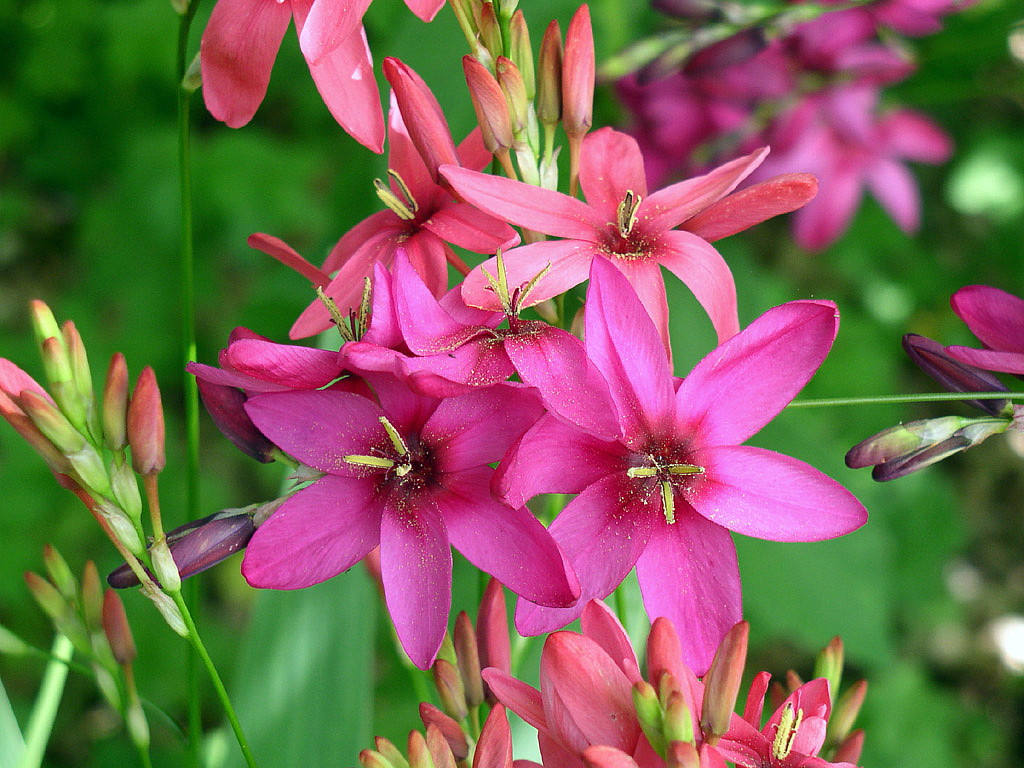Ixia flowers, also known as African Corn Lilies, trace their roots back to the Cape region of South Africa. These vibrant and delicate flowers have become increasingly popular across the world, and with good reason.
Beloved for their unique charm, stunning colors, and enchanting patterns – Ixia flowers make for beautiful additions to any garden. In their native habitat, Ixias thrive in well-drained soil, showcasing their adaptability and proving that they are rather hardy flowers.
Historically, Ixia flowers have been admired for their association with elegance and grace, making them a symbol of beauty and renewal.
The African corn lily (Ixia species) is a beautiful flowering plant that originiates from South Africa. This delicate flower goes through several distinct stages of growth before reaching full bloom. In this comprehensive guide, we will explore the different phases of the African corn lily life cycle.
Overview of the African Corn Lily
Also known as the wand flower the African corn lily belongs to the Iridaceae family. There are around 87 species in the Ixia genus. This perennial plant is prized for its sword-like foliage and colorful star-shaped flowers that bloom in spring and summer.
Native to South Africa, the African corn lily thrives in hot, sunny conditions. The flowers come in a diverse range of hues like white, yellow, orange, pink, red, and purple. When grown in colder climates, the African corn lily may perform as an annual.
Below we cover the five main stages of growth of this beautiful plant.
Stage 1: Germination
The life cycle of the African corn lily begins with the germination of the seeds. The small, rounded seeds are typically planted in well-draining soil in early spring. Warmth and moisture are critical for the seeds to germinate successfully.
During germination, the seed coat softens and the radicle (embryonic root) emerges first, followed by the plumule (embryonic shoot). With adequate sunlight, water, and nutrients, the seedling will develop its first true leaves and root system. Robust seedlings are vital for the plant to progress to the next stages.
Stage 2: Vegetative Growth
In the vegetative phase, the young African corn lily plant directs its energy towards establishing healthy roots, stems, and leaves. This stage prepares the plant for future flowering.
The roots grow bigger and deeper into the soil to anchor the plant. The main shoot elongates as leaves unfold along its length. The leaves are crucial for photosynthesis, allowing the plant to produce its own food. At this stage, good air circulation and sunlight are essential for strong vegetative development.
Stage 3: Bud Formation
As the African corn lily matures, reproductive structures begin to form. Flower buds start to develop at the tips of the stems, enclosed by protective layers of tissue.
Inside the buds, all the essential flower parts like the petals, sepals, stamens, and pistils slowly form. The buds also contain unopened flowers waiting for the right cues to bloom. During this stage, the plant allocates resources to nurture the buds.
Stage 4: Flowering
Flowering is the most vibrant and fleeting stage of the African corn lily life cycle. When buds are fully mature, they begin opening up into colorful blooms. The flower shape is classified as stellar or star-like.
Delicate, overlapping petals unfurl, revealing intricate patterns. Flower colors range from creamy white to bright yellow, pink, orange, red, or purple. The alluring flowers produce nectar to attract pollinators like bees, butterflies, and hummingbirds.
Pollination allows for reproduction through seed formation. The African corn lily blooms for several weeks, transforming gardens with its beauty. Peak flowering occurs in late spring or summer.
Stage 5: Seed Formation
After successful pollination and fertilization, the flowers start to fade as the petals drop off. In their place, seed pods begin swelling as they reach maturity. Inside, small black Ixia seeds develop.
The pods turn dry and brittle when the seeds are ripe. Cracking open, the pods release the seeds which fall to the ground. Under favorable warm, moist conditions, the seeds germinate and renew the African corn lily’s life cycle.
Alternatively, the seeds can be collected and stored in a cool, dry place for planting in the next season. Each pod contains multiple seeds.
Growing Conditions
To progress smoothly through its growth stages, the African corn lily requires specific care. Here are the optimal growing conditions:
- Sunlight: Full sun to partial shade (at least 6 hours of direct sun daily)
- Soil: Well-draining, sandy or loamy soil with high organic content
- pH: Neutral to slightly alkaline pH between 6.0-8.0
- Water: Moderate moisture, avoid overwatering
- Temperature: Minimum 60°F (15°C)
- Fertilizer: Use a balanced fertilizer in spring
- USDA zones: 8-10 as a perennial, 5-7 as an annual
Common Pests and Diseases
Some potential pests and diseases to monitor for include:
- Thrips
- Aphids
- Snails and slugs
- Scale insects
- Root rot
- Botrytis blight
- Mosaic virus
Catching problems early allows for prompt treatment to keep your African corn lily thriving.
Final Thoughts

Watering your Ixia Bulbs:
After planting, water the bulbs thoroughly to settle the soil around them. Keep the soil consistently moist but not waterlogged during the growing season. Adequate water is essential for the establishment of roots but waterlogging will lead to bulb rot.
Apply a layer of mulch around the planted Ixia bulbs. Mulching helps conserve soil moisture, suppresses weed growth, and also regulates soil temperature. Use organic mulch, such as straw or bark, for effective insulation.
•Planting Bulbs: Planting Ixia Bulbs as Garden Flowers
Select healthy Ixia bulbs! Remember to look for bulbs that are firm, free from signs of decay or damage, and have no mold or soft spots.
How to plant a pot of Ixia (corn lily)
FAQ
When to plant African corn lily bulbs?
Do Ixia bulbs come back every year?
How long does it take Ixia to sprout?
Do Ixia bulbs multiply?
